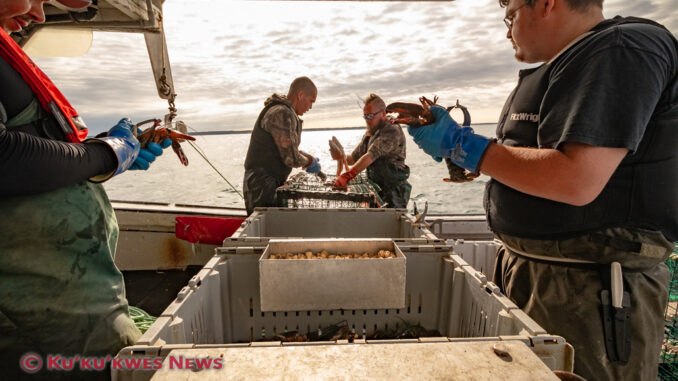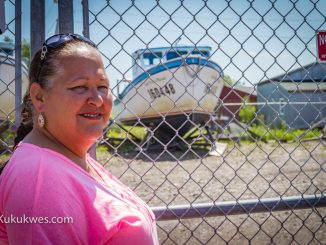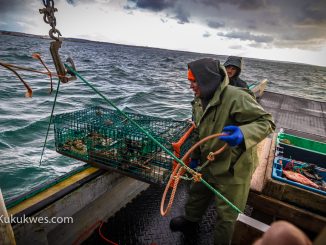
Terrence Augustine said his first week of lobster fishing under his treaty right to earn a moderate livelihood from the fishery was rough. He said non-Indigenous commercial fishermen cut the lines attached to the 50 traps he set in St. Mary’s Bay on Sept. 17, the day his community launched its own rights-based fishery.
“We caught them on camera and everything, checking our gear and cutting it up,” Augustine said on Friday.
“I went out and looked for them. I dragged for them and everything trying to find them and they weren’t there,” he said.

The Sipekne’katik First Nation member was one of the first seven harvesters from his community to receive a lobster license under the First Nation’s new moderate livelihood fishery. He was issued replacement tags when he reported that his trap lines were vandalized.
Augustine set 30 more traps in the bay but the majority of them were also vandalized. He was only able to recover ten of them. He then set 20 traps in the bay before Tropical Storm Teddy hit Nova Scotia last week and 20 more after the storm passed.
Augustine, 37, said each time he went out on the waters to set his traps, he was met with a fleet of non-Indigenous commercial harvesters who tried to intimidate him and his four-member crew.
Augustine’s 40 lobster traps remained untouched
On Friday morning, Augustine and his crew aboard his boat, The Lady Carol I, left the wharf in Saulnierville, N.S. to check on the condition of his 40 traps.
After a half hour in St. Mary’s Bay, Augustine reached the spot where he dropped his first line of ten traps. His all-male crew wasted no time in hauling them up. Two crew members moved quickly to remove the lobsters and placed more bait in the traps before dumping them back into the bay.
The other two crew members measured each lobster and check to see if any of them had a v-notch on their tails. They tossed the v-notch and undersized lobster back into the waters and placed elastic bands on the claws of the remaining ones before placing them into crates.

Augustine and his crew repeated this routine three more times throughout the morning before heading back to Saulnierville Wharf with three crates filled with approximately 400 pounds of live lobster. He said he was surprised to find his traps untouched this time.
“That’s the first time,” Augustine said, laughing. “We haven’t been able to fish until today.”
“I’m pretty happy about it,” he added.
“It’s pretty calm,” James Nevin, one of Augustine’s crew members, said about the morning boat trip in the bay compared to the week before.
“It felt really good today because we were actually able to fish for our moderate livelihood,” Nevin, 36, said. “(It’s) what we wanted to do in the first place.”

While the crew hauled lobster traps, an RCMP zodiac boat and a Canadian Coast Guard vessel were nearby observing their activities. At one point, a coast guard helicopter circled the boat.
Off in the distance, another coast guard vessel as well as several other fishing boats can be seen in waters down the coast towards nearby Meteghan.
Sipekne’katik hopes to buy lobster from community harvesters
With more than 400 pound of lobster in his possession, Augustine said he now needs to find a way to sell them.
“We’re not sure what we’re doing right now. Hopefully we can sell them if we’re allowed,” Augustine said.

Nevin said he believes the non-Indigenous commercial harvesters are telling local buyers in the Saulnierville area not to buy lobster from Mi’kmaw harvesters.
“In the commercial season, when you come in, you have your buyer. Your buyer is on the wharf waiting for you,” Nevin explained.
“We can’t do that right now. They’re basically doing the same intimidation tactics on buyers now as they did to us,” he said.
According to Nova Scotia regulations, provincially licensed fish buyers can only purchase lobster from harvesters with commercial licenses issued by the Department of Fisheries and Oceans.
Sipekne’katik Chief Michael Sack said during a news conference on Friday afternoon that his First Nation is in the process of establishing its own trade and transport regulations so it can purchase fish from community harvesters like Augustine.
The First Nation also wants both the federal and Nova Scotia government to recognize its right to sell fish.

“We’re looking to proceed with a lobster buying license of our own that we’re going to issue and that we’re looking for them to change the legislation,” Chief Sack explained.
“We still have some details to iron out but we want to see it as we buy our people’s lobster. We issue cheques for the lobster and when we’re free to sell it under our own management plan in (the) buying process,” he added.
Meanwhile, Sack confirmed that his First Nation has issued three more licenses under its moderate livelihood fishery.
In an email response to Ku’ku’kwes News, a spokesman with the Nova Scotia Department of Fisheries and Aquaculture said it is up to the federal government and Nova Scotia Mi’kmaq to determine “what constitutes legal harvesting under a moderate livelihood fishery.”
“As a province, our regulatory responsibilities are around health and safety to protect consumers, quality of the product, and the orderly development of the seafood industry,” the spokesman wrote.
Augustine needs to find more lobster traps
Augustine said he plans to store his lobster in crates in the water at the wharf until he can sell them.
In the meantime, he said he needs to search for ten more traps so he can use the remaining tags issued to him under his First Nation’s licensing regime.
Sipekne’katik Fisheries Director Brandon Maloney lent a hand on Friday to help out harvesters like Augustine in their search to replace lost or stolen traps.
Maloney and several other harvesters drove to the DFO office in Meteghan where non-Indigenous commercial harvesters dumped approximately 100 lobster traps in front of the office.

They checked the traps to see if they belonged to Sipekne’katik harvesters before loading them onto a large white truck.
“We’re here to reclaim them. Nobody else is doing anything about it,” Maloney said.
“We actually found one of the buoys (belonging) to one of the guys that had a livelihood license,” Maloney said.
“They did cut the tags off but these are ours that were stolen,” he said.
Once they filled the back of the truck with traps, Maloney and the others drove back to the wharf in Saulnierville with plans to return to fetch the remaining traps.




